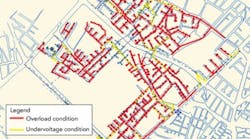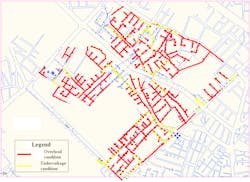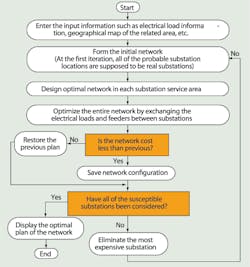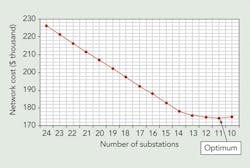The rate of load growth in Iran is around 6%. The country's distribution utilities are faced with rapid network development to supply all of the new customers. Design and implementation of the network expansion in a tight time scale requires sufficient basic information and adequate planning tools. In some areas, utilities are unable to keep pace with the fast development and, often, the planned network expansion plans lack technical and economic justification. Such an environment can result in underdesigning, where the network soon will become overloaded, or overdesigning, where the capacity installed is far greater than the connected load. Apart from imposing additional costs on the distribution utility, underdesigning also results in excessive network losses.
Tavanir Co., a power generation, transmission and distribution management company in Iran, has promoted a number of loss-reduction projects, which have resulted in a 2.5% reduction of total losses in recent years. However, the ratio of electrical energy losses in distribution networks has reached 16% of the total energy generated.
A priority of the Iranian Ministry of Energy is to assist utilities with their network problems by optimizing network planning through considering the load pattern, rate of load growth and life-cycle costs. This task was assigned to the Niroo Research Institute (NRI), the country's principal power research organization. Established in 1982, NRI is responsible for developing new technologies and software for the electricity supply industry.
Distribution Network Planning Problem
Nonstandard designs and the operation of distribution networks in overload and undervoltage conditions, improper and loose conductor connections, and unbalanced loads as a result of the connection of single-phase customers are among the reasons for the excessive energy loss.
In 2004, NRI, in cooperation with engineers from some electrical distribution utilities — North-Eastern Tehran Electrical Distribution Co., South-Western Tehran Electrical Distribution Co. and the Western Azerbaijan Electrical Distribution Co., supported by Tavanir Co. — embarked on a project to develop guidelines about optimal planning of distribution networks. Case studies were performed in different regions of Iran, and planning studies were completed for each of the three phases of the pilot project.
In the first phase of the pilot project, three service territories in Iran were selected for studying the application of optimum planning approaches. Each area had different environmental conditions, load densities and variations in the structure of the distribution network. The first phase took into account the green-field condition, an area without any existing electrical installations.
The second phase incorporated the existing distribution network into the planning optimization process for the three select areas.
Finally, the third phase took into account the existing network installed in the Western Azerbaijan Electrical Distribution Co.'s territory, located in northwest Iran, which had an investment budget of about US$1.2 million.
Based on the results of this research project, NRI developed advanced distribution planning software, DisPlan. The software was used to redesign Iran's distribution network in the pilot project's three select areas and evaluate the energy losses before and after the redesign.
Optimization and Loss Reduction
The distribution network software programs currently available on the market are analytical tools, not planning tools, that require the location of electrical sources, electrical loads and feeder paths. Analytical tools can perform different studies such as load flow and capacitor placement on the predefined network. However, in the case of a planning tool, the problem is quite different. A planning tool does not have any predefined network configurations, as it should be able to create the network configuration, but it still requires the location of loads and the municipal map of the area subject to planning. Creating the distribution network configuration with a radial nature, which is limited to the city municipal map, is a complicated task.
Among the models for optimal planning of distribution networks, branch exchange techniques have been developed to avoid the complexity of practical large-scale optimization problems in distribution networks. The branch exchange method (BEM) basically converts a radial network into a meshed network by connecting the tie lines. The radial structure is restored by opening other network feeders.
By making some modifications to the BEM, the proposed algorithm developed by NRI has achieved the ability to recognize distribution network structures. One of the main features of the proposed planning procedure is designing the distribution network exactly in compliance with the municipal maps.
Distribution networks in urban areas are surrounded by city streets and alleys, which compel network planners to install and extend the network along the admissible paths inside the city. This necessity would make some of the optimum planned designs useless if the municipal limitations and city regulations were not observed. Neglect of the city municipal map yields inaccurate results for two reasons: It inaccurately calculates the direct distance between two ends of the feeder sections and it fails to consider the municipal map.
The optimized feeder has a direct route from the distribution substation to the connected load, and this frequently can be routed through a residential building, where it is apparent the design cannot be implemented and installed. Thus, it is necessary to find alternatives for the feeder path and, often, this has two routes, for example, either side of the street. These problems force a requirement to take into account the real municipal maps in the optimum distribution planning process. This approach also should consider several other factors including life-cycle power and energy losses, repair and maintenance costs, outage costs and so forth.
However, another factor to which attention should be given is the simultaneous design and optimization of primary (medium-voltage) and secondary (low-voltage) networks. Research has shown this can drastically affect the result of the overall optimization process. The problem with optimal distribution system planning is minimizing the objective function after sufficient consideration of the following constraints:
-
Line and transformer current capacities
-
Voltage drop at each load point
-
Demand/supply balance
-
Radial configuration
-
City regulations, municipal map limitations.
An iterative algorithm is used for the optimization of distribution system planning. To achieve the final optimum distribution system plan, this includes several internal loops that link the medium- and low-voltage design process, which causes all the design stages that contain distribution substation capacities, location, medium- and low-voltage feeder sizing and routing to be done reciprocally.
Software Application Results
The software developed has been used to design the network for an area of 0.085 sq km (0.0328 sq miles), includes 811 residential and commercial customers with a total load of about 1 MW. Within these 24 possible locations for distribution substations, two positions for the 20-kV T-joints were suggested as software inputs.
Examination of the total overall cost of the network revealed that, starting with a possible 24 substations, the minimum cost is achieved by 11 distribution substations, as the software design algorithm takes into consideration network loss cost parameters.
Research Results
In countries like Iran that continue to have a large increase in annual demand, distribution utilities require access to planning tools that can design optimal distribution networks relatively quickly compared with those developed manually by design staff. Advanced innovative distribution planning software such as DisPlan can develop optimal distribution networks with or without considering the existing network on real municipal maps. Standardization of the distribution network made using an optimum planning process leads to improvements in power quality and lower operational costs. DisPlan is now accepted as an industry standard and readily available to design teams in the Iranian distribution utilities.
Future Research Program
NRI is already considering the impact of connecting distributed generation to existing distribution networks, and it plans to develop the software to incorporate the effect of distributed generation in distribution networks.
For asset management purposes, it is important to know when and where to install additional equipment. NRI is planning more upgrades to the planning software DisPlan to assist network operators with future expansion of the network.
Acknowledgments
The authors wish to acknowledge the following individuals: Gholamreza Khosh Kholgh, managing deputy director of distribution coordination for Tavanir, and Safar Farzalizadeh, director of the transmission and distribution research center for NRI, for their help; Babak Nikfam, managing director of Behin Raise Co., for the marketing of DisPlan, under license by NRI; AliArefi and Javad Olamaei for their invaluable assistance and advice; all the Iranian utility engineers and specialists who contributed to this project; and Mr. Zabihi, the planning specialist from Western Azerbaijan Electrical Distribution Co. for his cooperation.
Mojtaba Gilvanejad ([email protected]) received a BSEE degree from Power and Water University of Technology, Tehran, Iran, in 2004, and a MSEE degree from Iran University of Science and Technology, Tehran, in 2006. Gilvanejad is a Ph.D. student at Amirkabir University of Technology, Tehran, having received a scholarship from Niroo Research Institute. His research interests are distribution system planning and analysis, protection system design and reliability studies.
Mohammad Reza Shariati ([email protected]) received a BSEE degree from Iran University of Science and Technology, Tehran, Iran. He is secretary of IEC SC36C Iran, a member of CIGRÉ B2.21 Working Group and head of the transmission and substation department at Niroo Research Institute. His research interests are in the field of transmission and distribution networks.
Hamideh Ghadiri ([email protected]) was awarded a BSEE degree from Khaje Nasireddine Toosi University of Technology, Tehran, Iran, in 1995. Ghadiri is currently project manager of a national project on energy loss reduction and optimal planning of distribution networks for the transmission and substation department of Niroo Research Institute. Her research interests are power system operation, planning and control.
Sara Khayyamim ([email protected]) received a MSEE degree from Iran University of Science & Technology, Iran, in 2007. Khayyamim is currently engaged in Niroo Research Institute, Tehran, Iran, where her research interests include power system planning, loss reduction, heuristic algorithms and flexible ac transmission system devices.
Akbar Yavartalab ([email protected]) was awarded a BSEE degree from Tabriz University, Tabriz, Iran, in 1987, and a master's degree in management of information systems from Tehran University, Tehran, Iran, in 2002. Yavartalab is currently the general director of the distribution engineering department at Tavanir. His fields of interest are electrical distribution system planning, operation, and loss reduction and supplies to rural areas.
Companies mentioned:
Great Tehran Electrical Distribution Co. | www.tbtb.co.ir
Niroo Research Institute | www.nri.ac.ir
Tavanir | www.tavanir.org.ir






